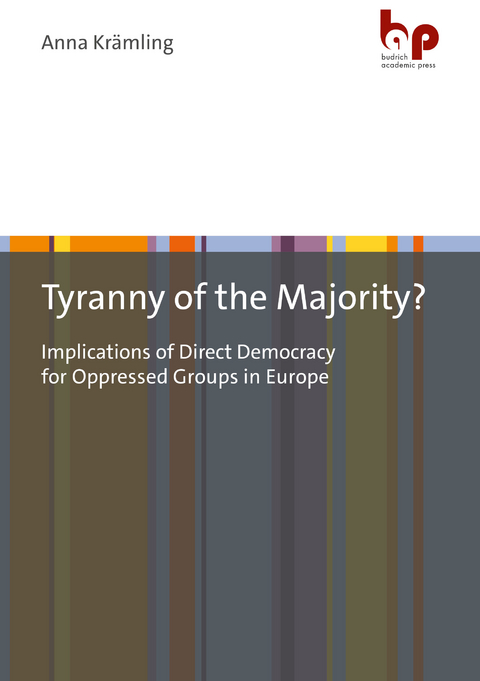Tyranny of the Majority?
Budrich Academic Press (Verlag)
978-3-96665-084-7 (ISBN)
Contents
Acknowledgements
Tables
Figures
Abbreviations
1 Introduction
1.1 Approach of this Dissertation
1.2 Research Questions
1.3 Roadmap of the Dissertation
2 Conceptual Frame and Definitions
2.1 The Concept of Oppressed Groups
2.1.1 Criticism and Use in the Social Sciences
2.1.2 Application in this Dissertation
2.2 The Definition of Direct Democracy
2.2.1 Pro- and Contra-Bills and -Outputs and Direct Democratic Instruments
2.2.2 Other Stages of the Direct Democratic Process
2.3 Direct Democracy and the Tyranny of the Majority
2.3.1 Reasons to Expect a Tyranny of the Majority
2.3.2 Reasons to Expect Empowerment
2.3.3 Different Implications for Different Oppressed Groups
2.3.4 Explaining Variables for the Probability of Pro- and Contra-Bills and –Outputs: Institutions
2.3.5 Explaining Variables for the Probability of Pro- and Contra-Bills and -Outputs: Socio-Economic Variables
2.4 Summary
3 State of the Art: Findings on Direct Democracy and Oppressed Groups
3.1 Negative Implications of Direct Democracy for Oppressed Groups
3.2 Positive Implications of Direct Democracy for Oppressed Groups
3.3 Explaining Variables
3.3.1 Institutional Effects
3.3.2 Attitudinal Effects
3.3.3 Socio-Economic Effects
3.4 Gaps in Existing Research
4 Hypotheses
4.1 Different Impacts for Different Groups
4.2 Explaining Variables: Institutional Effects
4.2.1 Direct Democratic Instruments
4.2.2 Quora
4.3 Explaining Variables: Attitudinal Effects
4.3.1 Negative Attitudes towards Outgroups
4.3.2 Support for Equality
4.4 Explaining Variables: Socio-Economic Effects
4.4.1 Education
4.4.2 Economic Growth
4.4.3 Ethnic Fractionalization
5 Methods and Data
5.1 Data
5.2 Methods
6 Descriptive Results
6.1 Oppressed Groups and Direct Democratic Bills
6.2 Oppressed Groups and Direct Democratic Outputs
6.3 Explaining Variables
6.3.1 Institutional Explaining Variables, Switzerland
6.3.2 Attitudinal and Socio-Economic Explaining Variables
6.4 Summary: Descriptive Results on Hypotheses
7 Bivariate Statistics
7.1 Explaining Variables and Pro- and Contra-Bills
7.2 Explaining Variables and Pro-Outputs
7.3 Explaining Variables and Contra-Outputs
7.4 Correlations between Explaining Variables
7.5 Summary: Bivariate Results on Hypotheses
8 Multivariate Statistics
8.1 The Probability of Pro-Bills
8.1.1 Variation between Countries and Years
8.1.2 Institutional Explaining Variables, Switzerland
8.1.3 Attitudinal Explaining Variable
8.1.4 Socio-Economic Explaining Variables
8.2 The Probability of Pro-Outputs
8.2.1 Variation between Countries and Years
8.2.2 Institutional Explaining Variables, Switzerland
8.2.3 Attitudinal Explaining Variable
8.2.4 Socio-Economic Explaining Variables
8.3 The Probability of Contra-Outputs
8.3.1 Variation between Countries and Years
8.3.2 Institutional Explaining Variables, Switzerland
8.3.3 Attitudinal Explaining Variable
8.3.4 Socio-Economic Explaining Variables
8.4 Diagnostics
8.5 Summary: What Determines the Fate of Oppressed Groups in Direct Democracy?
9 Discussion
9.1 Overview: Hypotheses and Results
9.2 Hypotheses 1a-c: Low SES Groups
9.3 Explaining Variables: Institutional Effects
9.3.1 Hypotheses 2a-c: Direct Democratic Instruments
9.3.2 Hypotheses 3a and b: Quora
9.3.3 Explorative Analyses: Binding Vote Results and Switzerland
9.4 Explaining Variables: Attitudinal Effects
9.4.1 Hypotheses 4a-c: Negative Attitudes
9.4.2 Hypotheses 5a-c: Support for Equality
9.5 Explaining Variables: Socio-Economic Effects
9.5.1 Hypotheses 6a-c: Education
9.5.2 Hypotheses 7a-c: Economic Growth
9.5.3 Hypotheses 8a-c: Ethnic Fractionalization
9.6 Summary: What Works Best for Oppressed Groups in Direct Democracy?
9.7 The Concept of Oppressed Groups in Direct Democracy
10 Conclusions
10.1 Oppressed Groups can Benefit from Direct Democracy
10.1.1 Addressing the Gap: A Quantitative, Comparative Analysis of Oppressed Groups in Direct Democracy
10.1.2 Results: Pro-Bills and –Outputs Outnumber Contra-Bills and -Outputs
10.1.3 Limitations and Avenues for Future Research
10.2 Binding Votes and Absence of Quora Benefit Oppressed Groups
10.2.1 Addressing the Gap: Multilevel Logistic Regressions
10.2.2 Results: Institutional Variables are Key
10.2.3 Limitations and Avenues for Future Research
10.3 It Depends on the Resources and Attitudes
10.3.1 Addressing the Gap: A Differentiated Analysis of Direct Democratic Votes
10.3.2 Results: Different Implications for Different Groups
10.3.3 Limitations and Avenues for Future Research
10.4 A Tyranny of the Majority?
Appendix
Appendix A: Codebook
Appendix B: Additional Analyses
Bibliography
Name Index
| Erscheinungsdatum | 17.04.2024 |
|---|---|
| Verlagsort | Leverkusen-Opladen |
| Sprache | englisch |
| Maße | 148 x 210 mm |
| Gewicht | 310 g |
| Themenwelt | Sozialwissenschaften ► Politik / Verwaltung ► Staat / Verwaltung |
| Schlagworte | democratic innovations • democratic votes • Demokratieforschung • Demokratische Innovationen • Direkte Demokratie • LGBTQ • Minderheiten • Minorities • Quantitative Analysen • Quantitative Analyses • Referendum • research on democracy • Volksabstimmungen |
| ISBN-10 | 3-96665-084-3 / 3966650843 |
| ISBN-13 | 978-3-96665-084-7 / 9783966650847 |
| Zustand | Neuware |
| Haben Sie eine Frage zum Produkt? |
aus dem Bereich




